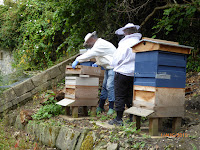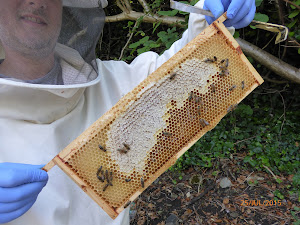Here are a few photos that Stewart took while I conducted my routine inspection of my beehives last weekend. I keep two hives – you might have seen them, just off the alley that runs from the end of St Marks Road up to Calton Gardens. Here are the hives:
 |
| Andy’s beehives |
First things first – open up the hive! The beehive is basically a stack of boxes, each with several frames of honeycomb inside. For this particular inspection I was mainly interested in looking at what was going on in the box at the bottom, where the queen bee lives. So, off with the roof, stack the top boxes to the side, and lift out a frame to take a look:
 |
| Unstacking the hive |
 |
| The unstacked boxes |
 |
| Bees on the frames |
This hive has a new queen, and she’s only been laying eggs for around three weeks. That’s important, because laying eggs is pretty much all a queen bee does – and she can lay 1,500 a day! For today’s inspection, I want to make sure she’s laying well, and therefore producing plenty of worker bees.
Let’s take a look at the frame of comb, and see if she’s been busy:
 |
| “Capped brood” |
Yes, very busy! All of those cells with the biscuit-coloured wax cappings are grubs that are pupating into adult bees. There are lots of capped cells – which means lots of new bees – which means a happy beekeeper! If you look carefully, you can also see some of the grubs (beekeepers usually refer to them as “brood”) – they look like curled-up pearly-white maggots.
So, I have plenty of workers, but where’s the queen…?
 |
| Can you spot the queen? |
This is a closer look at a different frame – this one has more empty cells. If the queen is on this comb, then she will methodically go through each empty cell, and lay an egg in the centre of each one. So, is she here? Yes! – if you look carefully you should be able to spot her – she is longer than the worker bees, and darker in colour.
But of course, the big draw of beekeeping is honey. I’m going to have a look at a frame in one of the other boxes, nearer the top of the hive to see how much has been collected:
 |
| Honey! |
Looking good – all the cells with the white wax caps have been fully processed, which is why the bees have sealed them shut. You can also see some dark, shiny cells – these contain nectar that is halfway to becoming honey, but the bees haven’t yet evaporated off enough water. Also, to the sides are some empty cells. I’m hoping the bees fill these over the next couple of weeks.
On to the other hive now. This one didn’t have a queen until recently – but the workers have made a new one, and I’m hoping she’s hatched out within the last couple of days. If she has, she will be quite shy, so this is a very quick inspection to check that she has hatched and all is well. As soon as I’ve seen her, I’ll put the hive back together and leave her alone.

Good news – I spotted her on this frame. Unfortunately, I was too quick, and put the frame back in the hive before Stewart could get a close-up shot. Now that I know she’s safe, I’m going to leave the hive alone for three weeks, and then check back in the middle of August to make sure that she’s started laying plenty of eggs to grow into new worker bees.







 Good news – I spotted her on this frame. Unfortunately, I was too quick, and put the frame back in the hive before Stewart could get a close-up shot. Now that I know she’s safe, I’m going to leave the hive alone for three weeks, and then check back in the middle of August to make sure that she’s started laying plenty of eggs to grow into new worker bees.
Good news – I spotted her on this frame. Unfortunately, I was too quick, and put the frame back in the hive before Stewart could get a close-up shot. Now that I know she’s safe, I’m going to leave the hive alone for three weeks, and then check back in the middle of August to make sure that she’s started laying plenty of eggs to grow into new worker bees.